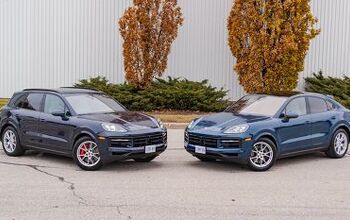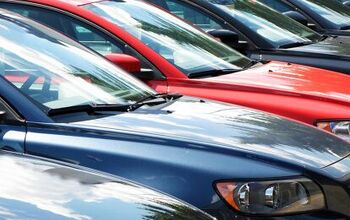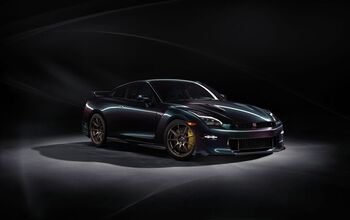Subaru Outback Vs Subaru Forester Comparison

You’ve got your heart set on a new Subaru family hauler. But you’re torn: do you go Forester, or Outback?
The Forester has gone from a slightly awkward-looking high-rider on the Impreza platform to a more conventional compact crossover … on the Impreza platform. In its shift to a true RAV4 competitor, the Forester offers plenty of practicality alongside the brand’s trademark ruggedness. It’s also something of a deal considering its standard AWD in class full of standard front-drive.
Meanwhile, the Outback is the de facto poster child of Subaru. What started as a lifted Legacy wagon has branched off into its own wildly successful model. The Outback is perhaps the truest crossover of them all: a car with a bit of extra cladding and ride height. Despite that seemingly simple recipe, the Outback still remains essentially in a class of one, a youthful, adventure-seeking option in the otherwise staid and safe mid-size segment.
These two siblings are close on size, price, and features. Only one will suit your crew’s needs best though, so let’s find out which it is, shall we?
Interior and Cargo Space
Forester: I started the week in the Forester, and the first impression is one of openness. The front windshield is huge, making it easy to see out ahead and know exactly where the nose ends. Visibility is excellent all-round, really, owing to the Forester’s more upright shape.
That boxiness translates to additional front-row head room, measuring 40.2 inches (1,020 mm). Legroom is a stretch-friendly 43.3 inches (1,101 mm) up front, and 39.4 inches (1,000 mm) for second-row passengers. I hope they aren’t too tall, however, as headroom is just 37.7 inches (957 mm) in the back. It’s a consequence of that giant moonroof—a worthy trade-off in our eyes, unless you’re regularly fitting folks over six-foot back there. The back seats themselves are reasonably comfortable, though the cushion is quite flat and slightly too low. Front seat accommodations are better. The leather seats are well-contoured, and adjustable enough to fit a variety of shapes and sizes. Taller drivers might wish for an adjustable thigh support, but overall, the Forester’s helm is a very comfortable place to be.
SEE ALSO: Toyota RAV4 vs Nissan Rogue ComparisonCabin material quality can’t quite match the comfort. The harder plastics lining the lower dashboard are not major offences in the compact crossover class, but the hollow-sounding door panels are. Specifically, it’s the portion around the door handles. The waffle texture is almost exactly the same as the sheets of wax I’d tear up every Easter to decorate eggs, and it doesn’t feel much better here. At least the armrests either side of the driver are nice and squishy. Bonus points for big, easy-to-use dials for the climate controls, too.
The Forester’s trunk will hold 28.9 cubic feet (818 L) with all seats in their upright positions. Drop the 60/40 second row and that grows to 69.2 cubes (1960 L). The opening is fairly square, and the lip is less than 29 inches (726 mm) off the ground.
Outback: Moving over to the Outback is like meeting up with a friend after they’ve had a dramatic new haircut. You recognize them, but it takes a minute. The basic design of the Outback’s interior is recognizably Subaru, with the same button-festooned steering wheel and a similar dashboard design—the latter now with a little storage shelf ahead of the passenger. Neon green stitching is a fun bit of character in a largely monochromatic setting. Of course, that big portrait-stye touchscreen is hard to miss, too.
Get a Quote on a New Subaru Forester or OutbackI didn’t think I’d ever be thankful for piano black trim, but here it is on the door panels, ditching the Forester’s pysanka wax texture. That change, along with the soft-touch dash covering, gives the Outback the edge in interior ambiance. Both managing editor Kshitij and I rate the seats highly—”possibly the most comfortable perches in the segment,” he says. The StarTex surface also makes them easy to clean after any muddy adventures. Ergonomic and highly adjustable, the front-row seats offer a great view out, even if there isn’t as much glass as the taller Forester.
On that note, front head room is at a premium in this Outback, matching the Forester’s rear row at 37.7 inches (958 mm). Blame the moonroof, which is a smaller item than the one on baby brother. Leg room is a half-inch down from the Forester too, though few will complain about 42.8 inches (1,087 mm). Rear-seat leg room just squeaks ahead of the Forester with 39.5 inches (1,004 mm), but head room is much better, at a hat-friendly 39.1 inches (992 mm).The perk of that small moonroof is the rear head room is the same across all Outbacks.
The Outback is larger in every dimension, so its larger 32.5-cubic-foot (920 L) trunk shouldn’t come as a surprise. That lead extends when the second-row seats are flat, a configuration that lets the Outback swallow 75.7 cubes (2,144 L) of stuff. The load lip is very slightly lower than the Forester’s, too.
Bottom Line: The Outback may be the larger vehicle, but that only translates into more cargo space, and more second-row head space. Its interior feels nicer however, and it’s that which propels it ahead for us.
Tech and Features
Forester: This Forester Limited tester includes nearly all the goodies of the top Touring trim (Premier in Canada). That includes leather seating, an 8.0-inch infotainment screen with native navigation, 10-way power adjustable driver’s seat with memory function, reclining rear seats, and more.
Subaru’s infotainment system ain’t pretty, but it works. It’s easy to navigate thanks to the colors, though there is a bit of lag. A major advantage over big brother Outback is the use of big physical dials for the climate controls. It makes it easy to adjust them on the fly. The secondary screen perched at the top of the dash displays the adjustments, which can be jarring at first, but ultimately keeps focus closer to the road. The air-con deserves special mention here: I picked up the Forester on a scorching-hot day and after only a few minutes the interior was as chilly as a Pingu’s abode. The nine-speaker Harman Kardon sound system is very good, too.
Kshitij praises the built-in navigation. “It’s well laid out and informative,” he says, “though it doesn’t seem to have traffic display and you sometimes end up in slow moving traffic in the express lane—ironic, I know.”
Canadian-spec models like this gain a few other perks over US models. This includes a power-adjustable front passenger seat, and heated outboard rear perches. No matter which trim you choose, on either side of the border, you won’t find a wireless charger. There are four USB ports; two in front, two in back.
Outback: The obvious difference here is the larger central screen. It runs the same UI as the Forester, with the extra real estate housing housing stats up top and climate controls below. Volume and tuning knobs remain, thankfully. The Outback makes do without the native navigation, but with standard Apple CarPlay and Android Auto like the Forester, you can use your preferred app. The Outback features dual-zone automatic climate control like the Forester, and adds voice control. The air-con blows just as cold and effective here as it does in the Forester, too.
The front passenger seat is a manually-adjustable affair on our Canadian-spec tester; it’s eight-way power-adjustable south of the border. A heated steering wheel is standard on our Canadian-spec tester; you need to step up to a higher XT trim for it in the US. Doing so also nets a 12-speaker Harman Kardon sound system, which doubles the speaker count in this tester. The Outback does benefit from auto up/down windows in all positions, instead of just the front row like the Forester. Both models have powered tailgates, but only the Outback’s is hands-free.
One welcome feature both Scoobies include is a running timer for the start-stop system. This keeps track not only of how long the engine has not been running, but how much fuel it hasn’t burned. It gamifies a relatively simple part of driving, encouraging drivers to put a little more thought into being eco- and wallet-friendly.
Bottom Line: We’re taking a stance here: the Outback’s screen might be bigger, but it’s not necessarily better. Adjusting the temperature remains easier in the Forester—and safer. Sure, the tablet-style setup is more eye-catching, but one of Subaru’s strengths has long been ease of use. Nothing’s easier than a dial. The Forester has the better sound system too, though the lack of a wireless charger is a strange omission on a model introduced in 2019.
Powertrain, Driving Feel, and Fuel Economy
Forester: When this generation of Forester debuted in 2019, Subaru pulled the turbocharged engine option from the lineup. Some folks will grumble about it, but the high-power model made up only a tiny fraction of Forester sales. Of course, it retains the brand’s traditional symmetrical all-wheel drive system, a heartier setup that always sends a percentage of the power to the rear axle, not just when the front is slipping, as is the case in most of the competition.
Now the Forester comes with just one engine option, the naturally-aspirated version of Subaru’s 2.5-liter boxer engine. With 182 horsepower and 176 lb-ft of torque, the Forester sits near the back of the class on-paper. In practice, however, the smaller Subaru gets around just fine, largely due to well-chosen ratios from the continuously variable transmission. There are wheel-mounted paddles to simulate gear shifts if you’re into that, but that doesn’t suit the Forester’s laid-back personality. Besides, holding gears reveals the boxer’s more agricultural sound higher up the rev range. Best to leave the CVT alone.
The low center of gravity of the boxer-four provides the Forester with solid, confidence-inspiring handling.Both the steering and brake pedal are well-weighted, making it easy to get comfortable piloting the Forester. You do feel higher in the air than in the Outback, but Kshitij and I agree it still feels more car-like than most of the competition. The Forester has a smooth, comfortable ride, only becoming too stiff when met with a series of big bumps in the road.
SEE ALSO: 2020 Subaru Ascent ReviewX-Mode offers drive modes for different road settings, adjusting engine and transmission responses as well as the AWD power distribution.
Fuel economy is bang-on with the rest of the class, with a quoted 26 mpg city (9.0 L/100 km) and 33 mpg highway (7.2 L/100 km), for a combined 29 mpg (8.2 L/100 km).
Outback: The turbo motor makes its presence known the first time I point the Outback at an on-ramp.The 2.4-liter produces a stout 260 hp, and the max 277 lb-ft of torque is available from 2,000 to 4,800 rpm. It’s doesn’t turn the Outback into a high-riding WRX, but there’s far less effort required to get up to speed, or execute passes. Helpfully, it’ll still run on good ol’ 87-octane regular gas, too. The rest of the drivetrain is the same as the Forester, with a CVT sending power to all four wheels.
An added bonus with the turbo engine: the snail muffles the noise from the boxer, making it the quieter of these two rigs. That being said, during my time with the Outback, every startup saw the idle sit just shy of 2,000 rpm for a minute or so.
The Outback rides with the same 8.7 inches (220 mm) of ground clearance as the Forester. Despite lugging around an extra 374 lb (170 kg) of weight, it’s more agile and rides softer than the Forester, smoothing over all but the worst bumps in the road. The Outback handles like a car much smaller than its 191.3-inch (4,860-mm) length suggests. Its steering is light, and the car feels planted.
The Outback includes X-Mode just like the Forester, though it’s accessible via touchscreen instead of dial.
Springing for a turbocharged wagon does take a hit on the wallet. The base-engine Outbacks match the Forester’s fuel economy figures, but XT models trim 3 mpg off every measurement. 23 mpg (10.1 L/100 km) city, 30 mpg (7.9 L/100 km) highway, and 26 mpg (9.1 L/100 km) is still on par with the class, however.
Bottom Line: The Forester is a comfortable, wholly likeable compact ute. It’s well-suited to the daily grind thanks to a smooth drivetrain and easy-going suspension tuning. But the Outback rides better, and the lure of turbo power is undeniable. It’s our pick.
Safety
Forester: Subaru has made its EyeSight suite of driver assists standard on all its CVT or automatic-transmission models, including the Forester. That means even the base model benefits from adaptive cruise control (with lane centering), pre-collision braking, lane departure with sway warning, lane keep assist, and high beam assist. Blind-spot detection, with lane change assist and rear cross-traffic alert, is optional on the Forester Premium in America, and standard on the mid-range Touring in Canada. Higher trims like this tester also include the DriverFocus system, which uses a driver-facing camera in the instrument panel to monitor eye movement for signs of fatigue.
SEE ALSO: Subaru Crosstrek vs Mazda CX-30 ComparisonThe Insurance Institute for Highway Safety (IIHS) gives the Forester its highest Top Safety Pick+ rating. Meanwhile, the National Highway Traffic Safety Administration (NHTSA) awarded the smaller Scooby a full five stars overall.
Outback: You’ll find all the driver assist features from the Forester in the Outback, though where it all ends up on the trim walk is slightly different. EyeSight is again standard, on all trims. Blind-spot detection, lane change assist, and rear-cross traffic alert become standard one rung up from base. The DriverFocus system is available on higher trims, but not on this here lowest turbocharged trim. The Onyx/Outdoor does get a 180-degree front camera, however.
As they share a platform, it should come as little surprise that the Outback and Forester post identical results from the IIHS and NHTSA. The Outback scores the same Top Safety Pick+ and five-star overall rating, respectively.
Bottom Line: Subaru includes a comprehensive suite of safety assists across both the Forester and Outback lineups. The two rides also net the top ratings from both the IIHS and NHTSA. It’s a tie for the cars, and a win for buyers.
Styling
Forester: Subaru’s penchant for unusual styling is a thing of the past, at least if you’re looking at the Forester. About the strangest thing on this compact cute-ute are the clamp-shaped taillights. We dig ’em. There’s a good amount of Ascent in the upright stance and subtly flared fenders. The front end is recognizably Subaru, thanks to the signature LEDs, hexagonal grille, and winged badge.
Kshitij sums it up when he calls the Forester’s styling “safe.” It won’t offend, but it might be hard to pick out in the parking lot.
Outback: Essentially a Legacy wagon, the Outback nonetheless dials up the visual aggression with some chunky plastic cladding all around the lower sections of the body. Subaru’s designers have shown some restraint in parts like the scalloped side skirts, which pull visual weight out of the bottom of the car. “It looks almost like a kayak with four doors and a trunk and I personally find that pretty cool,” says Kshitij.
Chunky roof rails make it clear the Outback is ready to be put to work, too.
Bottom Line: The Forester looks like it came out of the mold labelled “default compact crossover.” The Outback is still clearly a wagon—which, if we’re honest, is what the vast majority of crossovers are anyway. Both will surely look right at home at the campgrounds—or literally anywhere in Vermont.
Pricing
Forester: This particular Forester tester is the penultimate Limited trim. At $34,505 ($40,595 CAD) as-tested, it comes with the optional $1,695 package, which includes reverse automatic braking, native navigation, a nine-speaker Harman Kardon audio system, and heated steering wheel. All of that is standard in Canada, which goes some ways to explaining the Limited’s price proximity to the top trim. That one, called Touring in America and Premier in Canada, is essentially a visual package, adding a whole bunch of exterior chrome. The top trim adds a power-adjustable front passenger seat in the US, but it too is included on the Limited in Canada.
The Forester lineup begins at $25,845 ($30,795 CAD), managing to undercut some of the compact crossover competition despite offering standard all-wheel drive.
SEE ALSO: Subaru Outback vs Chevrolet Blazer ComparisonOutback: This Canadian-spec Outback is the Outdoor XT version, known as the Onyx Edition XT in America. It has the distinction of being the cheapest way into a turbocharged Outback, at $36,195 ($41,170 CAD). Canadians get a few other goodies that are optional south of the border, however. A $1,845 option package bundles the power moonroof, larger infotainment screen, and reverse automatic braking together, and the wireless charger runs $259. That results in an equivalent $38,299 as-tested price in America.
If you’d rather trade power for creature comforts, the better-equipped Outback Touring (known as Premier in Canada) comes with a sticker for $38,545 ($43,070 CAD). Upgrading to the turbo engine adds $2,500 ($2,800 CAD) to the bottom line.
Meanwhile, the cheapest way into an Outback is the $27,845 ($32,870 CAD) base trim. That’s a whole lot of car for not a lot of cash, and just two grand over the Forester.
Bottom Line: Consider nothing but the cold, hard numbers, and of course the Forester has the win here. This category largely depends on which part of the border you reside, however. In Canada, the price difference is a few hundred bones—about what you’ll need to snag a PlayStation 5 off a reseller. That makes the Outback’s extra cargo space and turbo power hard to ignore. The difference in the US approaches $4,000 though, and at that point we’d have to have a long think about how much those two things really matter.
Verdict: Subaru Forester vs Subaru Outback Comparison
Subaru has put in the work to produce two great crossovers here. The Forester doesn’t top any one aspect of the hyper-competitive compact segment, but it’s never far off either. The result is an incredibly likeable package that is big on everyday practicality.
We find ourselves drawn to the Outback, however. In the Onyx/Outdoor XT trim, it offers fantastic value for money, and doesn’t feel appreciably less premium than the higher-trim Forester. Kshitij sums it up best: “where the Forester feels it is better geared towards a family, the Outback XT is more youthful and sporty.” Whether you’re young or simply young at heart, it’s the one we’d recommend.
Become an AutoGuide insider. Get the latest from the automotive world first by subscribing to our newsletter here.

Kyle began his automotive obsession before he even started school, courtesy of a remote control Porsche and various LEGO sets. He later studied advertising and graphic design at Humber College, which led him to writing about cars (both real and digital). He is now a proud member of the Automobile Journalists Association of Canada (AJAC), where he was the Journalist of the Year runner-up for 2021.
More by Kyle Patrick


















































Comments
Join the conversation
Really fun of subaru legacy saloon of 2014 - 2016
I recently purchased a 2022 Subaru Forrester Limited my wife has a 2017 Subaru outback touring we both love the cars the Forrester gives you a better upright seating position with a bigger view and very comfortable front seats but the outback Front seats are quite comfortable too but I do think the Forrester to me is much more fun to drive. By the way we did own a 2004 Subaru Forrester which we traded it in on the brand new 2017 outback. The 2004 Subaru Forrester at that time have a little over 200,000 miles no major issues just the basic oil change tires and brakes